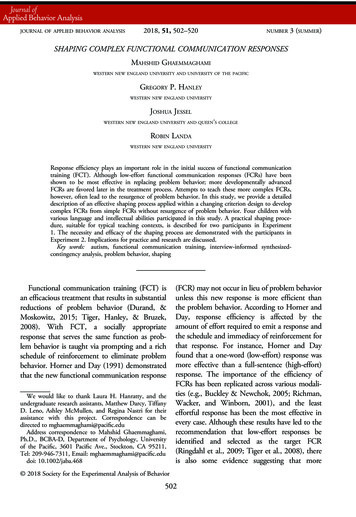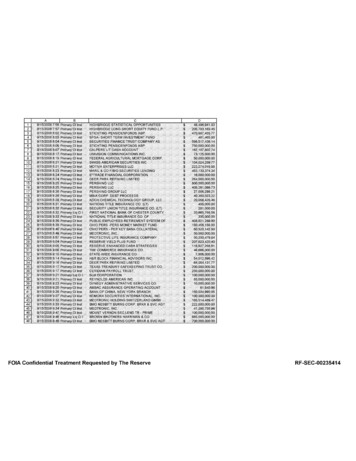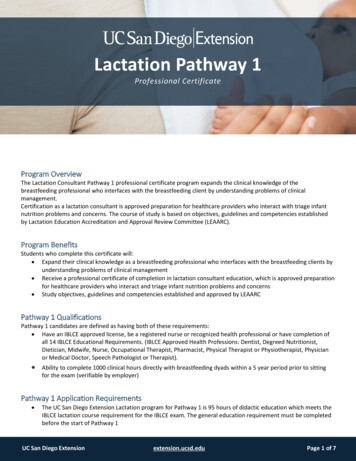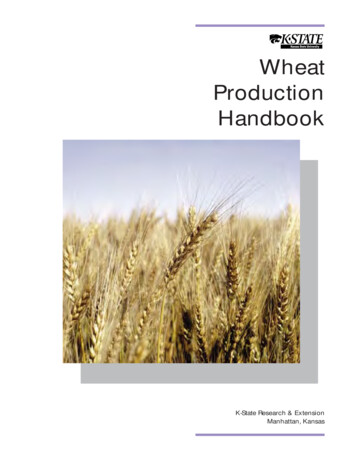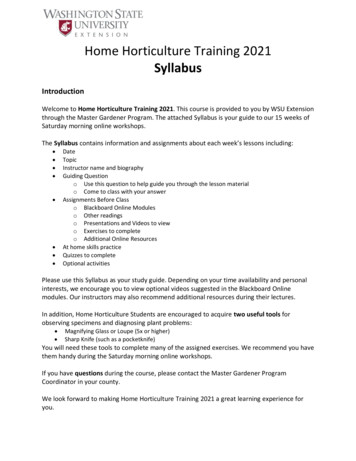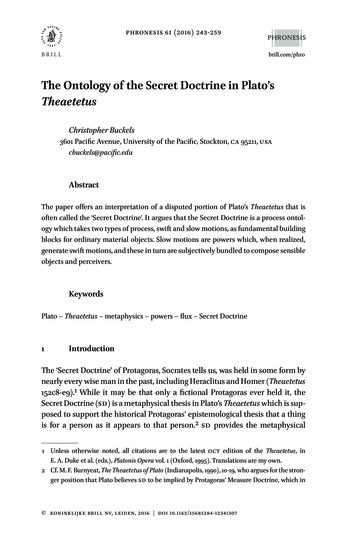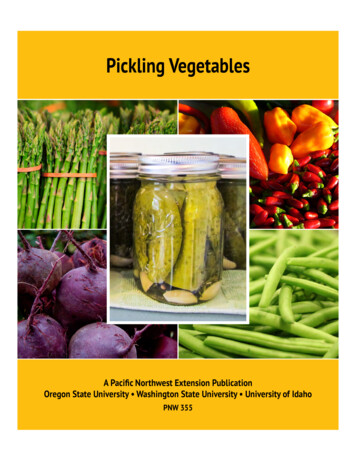
Transcription
Pickling VegetablesA Pacific Northwest Extension PublicationOregon State University Washington State University University of IdahoPNW 355
Pickling VegetablesSafety Checklist Select tender vegetables without blemishes or mold. Use the amounts and types of ingredients specified inlaboratory-tested recipes. Do not reduce the amount of vinegar or increase theamount of water in recipes. Follow instructions for conventional processing oruse lower-temperature pasteurization. Do not process brined pickles before they taste tart. Look for signs of spoilage before using pickledproducts.ContentsPickling Vegetables. . . . . . . . . . . . . . . . . . . . . . 2Preservation by Pickling . . . . . . . . . . . . . . . . . . 2Equipment for Fermenting. . . . . . . . . . . . . . . . 3Other Equipment . . . . . . . . . . . . . . . . . . . . . . . . 3Ingredients . . . . . . . . . . . . . . . . . . . . . . . . . . . . . 4Packing the Jars . . . . . . . . . . . . . . . . . . . . . . . . . 6Processing. . . . . . . . . . . . . . . . . . . . . . . . . . . . . . 6Storing. . . . . . . . . . . . . . . . . . . . . . . . . . . . . . . . . 8Recipes . . . . . . . . . . . . . . . . . . . . . . . . . . . . . . . . 9Dill Pickles. . . . . . . . . . . . . . . . . . . . . . . . . . . 10Sauerkraut. . . . . . . . . . . . . . . . . . . . . . . . . . . 10Quick Kosher Dills . . . . . . . . . . . . . . . . . . . . 11Quick Sweet Pickles. . . . . . . . . . . . . . . . . . . 12Bread-and-Butter Pickles . . . . . . . . . . . . . . 13Sweet Gherkin Pickles. . . . . . . . . . . . . . . . . 13Pickled Asparagus. . . . . . . . . . . . . . . . . . . . . 14Pickled Dilled Beans . . . . . . . . . . . . . . . . . . 14Pickled Three-Bean Salad. . . . . . . . . . . . . . 15Pickled Beets. . . . . . . . . . . . . . . . . . . . . . . . . 15Pickled Hot Peppers. . . . . . . . . . . . . . . . . . . 16Marinated Whole Mushrooms . . . . . . . . . . 16Sweet Pickle Relish . . . . . . . . . . . . . . . . . . . 17Dill Pickle Relish (Hot Dog Relish). . . . . . . 17Summer Squash Relish . . . . . . . . . . . . . . . . 17Reduced-Sodium Sliced Sweet Pickles. . . 18No-Sugar-Added Sweet Cucumber Slices. 182Pickling VegetablesPickling is one of the oldest methods of food preservation. The Chinese were fermenting vegetables as early asthe third century BCE. By the first century CE, the Romanswere pickling. Pickled products also appeared early inAmerica, and the pickle barrel was common during thecolonial days. Pickles even became part of our folklore, aschildren learned to recite the “Peter Piper picked a peckof pickled peppers” tongue twister. By the early 1920s, theU.S. Department of Agriculture (USDA) had publishedinstructions on making pickles at home. Many of theseprocedures are still used today.Preservation by PicklingMicroorganisms are always on vegetables. Proper homecanning prevents the growth of the microorganisms thatcause spoilage and illness. When the acidity of a cannedfood is high, harmful bacteria such as Clostridium botulinum cannot grow. That is why pickling (adding acid)prevents spoilage.There are two types of pickles: Brined (fermented) pickles require several weeks of“curing” at room temperature. During this period,colors and flavors change. Acid is produced as lacticacid bacteria grow. Quick (unfermented) pickles are made in 1 or 2 daysby adding acid in the form of vinegar. It is critical toadd enough vinegar to prevent bacterial growth (see“Vinegar,” page 4).Pickling Vegetables
Equipment for FermentingCrockA 1-gallon container is needed for each 5 pounds of fresh vegetables. Therefore, a 5-gallon stoneware crock is an ideal size for fermenting about 25 pounds of fresh cabbage or cucumbers. Select a crockthat is made for food use. Food-grade plastic and glass containers areexcellent substitutes. Sauerkraut may be fermented in quart or halfgallon jars.Caution: It is not safe to use garbage cans or other containers thatare not made to come into contact with food for humans.WeightA weight keeps fermenting food under the brine. When using acrock, select a dinner plate or glass pie plate that is slightly smaller thanthe container opening. Weigh it down with 2 or 3 quart jars that arefilled with water and have closed lids.You also can use a large, food-grade plastic bag (either heavyweightor double-bagged) as a weight. Fill the bag with brine (1½ Tablespoonssalt per 1 quart water) and close it. Place the bag in the fermentationcontainer to cover and hold down the fermenting food. Using brineprevents dilution in case the bag leaks.Cabbage and cucumbers must be kept 1 to 2 inches under the brinewhile fermenting. After weighing down, cover the container openingwith a clean, heavy bath towel to prevent contamination from insectsand molds during fermentation.Other EquipmentUtensilsPhoto: Jeanne Brandt, Oregon State UniversityDo not use zinc, copper, brass, galvanized metal, or iron utensils.These metals may react with acid or salt and affect the quality (colorchanges) and safety of pickles.JarsProcessing times are based on standard-sized, Mason-type jarsdesigned for home canning use. Inspect jars for cracks and chips, anddiscard damaged ones.LidsTwo-piece, metal canning lids and screw bands are recommended.Follow the manufacturer’s instructions for preparing the lids. Toprevent sealing failures, do not reuse lids. Wash the screw bands anddiscard any with dents or rust.Pickling Vegetables3
Image courtesy of theNational Center for Home Food PreservationBoiling Water CannerThese canners, made of aluminum or porcelain-covered steel, haveremovable baskets and fitted lids. Any large container may be used if ithas room for at least 1 inch of water to briskly boil over the tops of jarsduring processing. Place a metal rack in the bottom of the containerto keep the jars from resting directly on the bottom, which can causebreakage.IngredientsVegetablesSelect tender vegetables without blemishes or mold and thoroughlywash them in cold water. When you select cucumbers, keep the following points in mind: Use varieties grown especially for pickling. Avoid commercially waxed cucumbers; pickling liquid cannot penetrate the wax easily. Pick cucumbers early in the morning and use within 24 hours, forbest quality. Select cucumbers of similar size: 1½ inches long for gherkins,4 inches for dills. Use oddly shaped and more mature cucumbersfor relishes and bread-and-butter style pickles. Trim off the blossom end of the cucumber; it may contain enzymesthat soften the pickles.Select tender vegetables withoutblemishes or mold.SaltPhoto: Jeanne Brandt, Oregon State UniversityBoiling water canner Pickling and canning salts are the best choices.Table salt may be used, but the additive that prevents caking maymake the brine cloudy.Reduced-sodium salts (such as potassium chloride) may be used inquick pickle recipes; however, the pickles may have a slightly different taste.Do not use flake salt or kosher salt because they vary in density. Donot use rock salt or sea salt, which have impurities.Caution: Do not use reduced-sodium salt in brined pickles orsauerkraut—these products need a specific amount of sodium tocontrol bacterial growth and give a firm texture.VinegarVinegar is the most important ingredient in quick-pickle recipes.Without an adequate amount, the pickles will not be safe to eat. Useany vinegar with 5% acidity.4Pickling Vegetables
Caution: Do not reduce the amount of vinegar or increase theamount of water in a recipe. For a less sour taste, add a smallamount of sugar. White distilled vinegar has a pungent taste. Use it when picklinglight-color foods such as cauliflower and onions.Cider vinegar has a milder flavor. It will make a darker brine.Caution: Do not use homemade vinegar. It varies in acidity. Spices should be fresh. Whole spices are best. Powdered spices maycause the pickles to darken and the brine to become cloudy.Dill may be used fresh, or as seeds or oil. The flavor of dill seedsmay not be as good as fresh dill (1 teaspoon seeds equals 1 dillhead). To use dill oil, substitute one drop for each head of dill.Fresh dill freezes well.Garlic should be fresh and at the peak of maturity. Immature orsprouting garlic can turn blue in the jar.Sugar may be either white or brown. Brown sugar may give adarker color to the brine. Corn syrup and honey may give an undesirable flavor.Water Photo: Rachel Beck, Oregon State UniversityFlavoringsPlace flavorings at the bottom of a clean,suitable container.Soft water makes the best brine for pickles.Hard water may cause cloudiness in the brine and discolor pickles.If only hard water is available, boil and let it sit for 24 hours. Skimoff scum and use water from the top of the container without disturbing any sediment.Firming IngredientsPhoto: Jeanne Brandt, Oregon State UniversityIf fresh, good quality ingredients are used and up-to-date procedures and processes are followed, you should not need firming agentsto make crisp pickles. Soaking cucumbers in ice water for 4 to 5 hoursprior to pickling is a safe method for making crisp pickles. If youchoose to use firming agents, be sure to use food-grade products andfollow the manufacturer’s instructions. Pickling lime contains calcium. Cucumber or vegetable slices aresometimes soaked in a lime and water solution for 12 to 24 hoursbefore pickling. Be sure to remove excess lime by rinsing and soaking the cucumbers for 1 hour in fresh, cold water and then repeating the process two more times. The excess lime must be removed.Caution: Do not use lime sold at garden centers or lumberyards.Pickling Vegetables5
Calcium chloride for pickling is often sold where you buy canningsupplies. It is usually added directly to the jars of pickles. Follow theinstructions on the package for use.Alum may also be used to firm fermented cucumbers. However, itis not necessary and is not included in this publication. Alum doesnot improve the firmness of quick pickles.Packing the JarsPhoto: Rachel Beck, Oregon State University1. Wash the jars in hot, soapy water and rinse well. Keep them hotuntil ready for use by placing them in the canner filled with hotwater or in a hot dishwasher. Jars that will be filled with food andprocessed for less than 10 minutes should be sterilized by boilingthem for 10 minutes. Follow manufacturer’s directions for preparing lids.2. Prepare ingredients.3. Follow instructions for packing hot (vegetables preheated in brine)or raw ingredients into hot jars.4. Pack food and liquid to within ½ inch from the top of the jar,unless otherwise specified. If the jars are too full, some contentscould siphon out of the jar during heat processing, stick to the rim,and prevent sealing. All air may not be exhausted during processing if the space between the packed food and liquid and the top ofthe jar (headspace) is too large.5. Run a plastic spatula around the inside of the jar to remove air bubbles. Adjust headspace, if needed.6. Wipe jar rims and threads with a clean, damp cloth to remove anybits of food that might prevent a seal.7. Adjust lids and screw bands.ProcessingPickles are processed to stop fermentation and the growth of bacteria that cause spoilage.Use either conventional boiling water canner processing or lower-temperature pasteurization, if a firmer result is desired and therecipe allows for this method.Caution: It is extremely important to wait until fermented picklestaste tart before processing.Conventional, Boiling Water Canner Processing1. Arrange the filled jars on the rack of a canner filled halfway withvery hot water (140 F for raw-packed foods, 180 F for hot-packedfoods). Add more very hot water, if needed, to bring the water level6Pickling Vegetables
Photo: Rachel Beck, Oregon State Universityup to 1 to 2 inches above jar tops. Place a tight-fitting cover on thecanner.2. Turn heat to the highest setting and wait for the water to come toa full, rolling boil. When the water boils, set a timer for the recommended time. Increase processing times for higher altitudes,as directed, to make up for the lower boiling point of water. Keepwater boiling gently and steadily. Add boiling water, if necessary, tokeep jars covered.3. At the end of the processing time, turn off the heat and remove thecanner lid. Wait 5 minutes before removing the jars. Spoilage couldoccur if jars are left in hot water.4. Using a jar lifter, remove the jars, being careful not to tilt them.Put jars on a rack or heavy towel so air can move freely aroundthem. There should not be a cold draft or fan blowing on the jars.Let the jars sit undisturbed while they cool for 12 to 24 hours. Donot tighten the screw bands or press down on the center of the flatmetal lid until the jars are completely cool.Start timing when the water reaches afull, rolling boil.Pasteurization at Lower TemperaturesProcessing at temperatures lower than the boiling point of watermay result in a firmer or more crisp, final pickled product. Followdirections carefully to avoid possible spoilage.Caution: Use this method only when the recipe indicates that itis an option.Photo: Jeanne Brandt, Oregon State UniversityUse an instant-read thermometer or a candy, jelly, or dial thermometer that registers in the 120 F to 185 F range.1. Place filled jars on a rack in a canner half filled with warm water(120 F to 140 F). Add hot water to a level of 1 inch above jars.2. Heat the water to 180 F to 185 F and start a timer. Process for30 minutes, checking with a candy or jelly thermometer to be certain that the water temperature stays at least 180 F (temperatureshigher than 185 F may soften pickles).3. Immediately remove jars from the canner at the end of processingtime.4. Using a jar lifter, remove the jars, being careful not to tilt them. Putjars on a rack or heavy towel so air can move freely around them.Let the jars sit undisturbed while they cool for 12 to 24 hours. Donot tighten the screw bands or press down on the center of the flatmetal lid until the jars are completely cool.Testing the SealsTest each jar within 12 to 24 hours. Jars with flat, metal lids aresealed if: The lid has popped down in the center and does not move fartherdown when you press on it.Pickling Vegetables7
The center of the lid gives a clear, ringing sound when you tap itwith a spoon. Note: This is not as reliable as the first method.Jars that have not sealed can be either refrigerated or reprocessed.To reprocess, start by removing the lid. Check and clean the sealingsurface (the rim) of the jar. The brine in the jar must be reheated toboiling before reprocessing. Use a new lid and process again for thefull time. The quality of the pickled food will not be as good afterreprocessing.Caution: If jars unseal during storage, do not consume.Photo: Jeanne Brandt, Oregon State UniversityStoringRemove screw bands for storage so that the liquid under them willnot cause rusting.Wipe the jars and label them with the date, contents, and processinginformation.Store jars in a cool, dark, and dry place.After processing and cooling, store jars of pickles 4 to 5 weeks todevelop ideal flavor.Use within 1 year for best eating quality and nutritive value.Exposure to heat, freezing, or light decreases the quality and shelf lifeof canned food.Using PicklesAs you select each jar for use, examine it for signs of spoilage. Checkthe lid for tightness and vacuum seal. With the jar at eye level, examinefor streaks of dried food on the outside of the jar. Inside of the jar, lookfor cloudy canning liquid, rising air bubbles, or any unnatural color.While opening the jar, watch for spurting liquid or cotton-like moldgrowth on food surfaces or the underside of the lid. Smell for unnaturalor off odors.Caution: Never taste food from a jar with an unsealed lid or foodthat shows signs of spoilage.Carefully discard any jar of spoiled food to prevent possible illnessto you, your family, or your pets. Any pickles not prepared accordingto these or other laboratory-tested recipes should be treated as havingbotulism and handled in one of two ways: If the suspect jars are still sealed, write on the jarDanger: Poison.Do Not Eat.Place the jars in a heavyweight garbage bag. Close and place thebag in a regular trash container or dispose of in a nearby landfill.8Pickling Vegetables
If the suspect jars are unsealed, open, or leaking, they should bedetoxified before disposal (see below).Detoxification ProcessWear rubber or heavy plastic gloves when handling suspect foodsand cleaning up. Remove the jar lids and carefully place the suspect jarson their sides (along with the lids) in a stockpot, pan, or boiling watercanner (8-quart volume or larger). Carefully add water to the pot untilthe level is 1 inch above the jars. Put a lid on the pot and heat the waterto boiling. Boil for 30 minutes to detoxify the food. Cool and discardthe food and lids. Wash jars and pot.Spray or wet contaminated surfaces (such as counters and cuttingboards) with a room-temperature household chlorine bleach solution(1 part unscented 5% to 6% sodium hypochlorite bleach to 5 partsclean water) and let stand for 30 minutes. Wipe up treated spills withpaper towels and put them in a plastic bag before discarding in thetrash. Rinse surfaces. Soak metal utensils in a mild chlorine solution(1 teaspoon bleach to 1 quart room-temperature water) for 30 minutes.Rinse. Wash your gloved hands well.RecipesMost of the recipes in this publication for brined and quick picklesare from the USDA’s Complete Guide to Home Canning. For additionallaboratory-tested recipes, contact your local Extension office. If youwant to use pickle recipes from other sources, see the suggestions belowto ensure your recipes are safe.Current Pickle RecipesPickling VegetablesPhoto: Jeanne Brandt, Oregon State UniversityPickle recipes, ingredients, and processing recommendationshave changed over the years. To ensure that your pickles are safeand successful, check your recipe with these pointers in mind: Use up-to-date recipes from reliable sources. Make sure to use vinegar that is 5% acidity. Fresh or quick-pack pickle recipes should have at least as muchvinegar as water. If lime is included, the recipes must have a rinsing step. Brined pickles or sauerkraut must include salt. Processing instructions must be correct. Quick pickles must beprocessed as soon as they are made. Fermented pickles mustnot be processed until they have a sour taste.9
Dill PicklesIngredients4 pounds pickling cucumbers (4-inch)2 Tablespoons dill seed, or 4 to 5 heads fresh or drydill weed8 cups water¼ cup vinegar (5% acidity)½ cup salt2 cloves garlic (optional)2 dried red peppers (optional)2 teaspoons whole mixed pickling spices (optional)ProcedureWash cucumbers. Cut 1 16 inch off blossom endbut leave ¼ inch of stem at the other end. Place halfof the dill and half of the other flavorings on thebottom of a clean, suitable container (see page 3).Add cucumbers, remaining dill, and desired spices.Dissolve salt in vinegar and water, and pour overcucumbers. Add suitable weight and cover.Store for about 3 to 4 weeks in a location wheretemperature is 70 F to 75 F. Temperatures of 55 F to65 F are acceptable, but the fermentation will take5 to 6 weeks. Pickles will become too soft if temperatures are above 80 F during fermentation.Check the container several times a week andpromptly remove surface scum or mold.Caution: If the pickles become soft or slimy,or if they develop a disagreeable odor,discard them.Fully fermented pickles may be stored in theoriginal container for 4 to 6 months, provided yourefrigerate them and remove surface scum andmolds regularly.Canning is a better way to store fully fermentedpickles. To can them, pour the brine into a pan, heatslowly to a boil, and simmer 5 minutes. Filter brinethrough paper coffee filters to reduce cloudiness, ifdesired. Fill hot pint or quart jars with pickles andhot brine, leaving ½-inch headspace. Remove airbubbles and adjust headspace, if needed. Wipe rims10and adjust lids. Process as follows or use thelower-temperature pasteurization treatmentdescribed on page 7.Hot Pack Processing Times for Dill PicklesJar sizeAt an altitude of0–1,000 ft1,001–6,000 ftabove6,001 ftPint10 min.15 min.20 min.Quart15 min.20 min.25 min.SauerkrautIngredientsUse the following quantities for each gallon of yourcontainer’s capacity.5 pounds cabbage3 Tablespoons canning or pickling saltQualityFor the best sauerkraut, use firm heads of freshcabbage. Start sauerkraut within 24 to 48 hours afterharvest.YieldAbout 4 to 6 pints or 2 to 3 quartsProcedureWork with about 5 pounds of cabbage at atime. Discard outer leaves. Rinse heads under coldrunning water and drain. Cut heads in half andremove cores. Shred or slice to the thickness of aquarter. Put shredded cabbage into an extra-largebowl or food-safe tub, and add salt.Using clean hands, thoroughly mix in salt untiljuices are drawn from cabbage and salt is dissolved.Photo: Jeanne Brandt, Oregon State UniversityBrined (Fermented) FoodsPickling Vegetables
Fully fermented sauerkraut may be kept tightlycovered in the refrigerator for several months, or itcan be frozen or canned as directed below.Photo: Jeanne Brandt, Oregon State UniversityHot PackBring sauerkraut and juice to a boil, and packinto hot jars leaving ½ inch headspace. Remove airbubbles and adjust for headspace if needed. Wiperims, adjust lids, and process in a boiling watercanner as follows:Photos: Jeanne Brandt, Oregon State UniversityPack firmly into a suitable fermenting container(see page 3). Repeat shredding, salting, and packingwith additional cabbage, if desired. Be sure that thecontainer is deep enough so that its rim is at least4 or 5 inches above the cabbage.Hot Pack Processing Times for SauerkrautJar sizeAt an altitude of0–1,000 ft1,001–6,000 ftabove6,001 ftPint10 min.15 min.20 min.Quart15 min.20 min.25 min.Raw PackFill hot jars with sauerkraut and juices, leaving½ inch headspace. Remove air bubbles and adjustfor headspace if needed. Wipe rims, adjust lids, andprocess in a boiling water canner as follows:Raw Pack Processing Times for SauerkrautJar sizeIf juice does not cover cabbage, add boiled andcooled brine (1½ Tablespoons of salt per quart ofwater). Add plate and weights, and cover containerwith a clean bath towel.Store at 70 F to 75 F while fermenting. At temperatures between 70 F and 75 F, sauerkraut will befully fermented in 3 to 4 weeks; at 60 F, fermentationmay take 5 to 6 weeks. At temperatures lower than60 F, kraut may not ferment; above 75 F, kraut maybecome soft.If you use a plate and jars as weight, check thesauerkraut two or three times each week and removescum if it forms. If you weigh the cabbage down witha brine-filled bag, you will not need to disturb thecrock until normal fermentation is complete (whenbubbling ceases).Pickling VegetablesAt an altitude of0–1,000 ft1,001–3,000 ft3,001–6,000 ftabove6,001 ftPint20 min.25 min.30 min.35 min.Quart25 min.30 min.35 min.40 min.Quick (Unfermented) FoodsCaution: It is not safe to reduce theamount of vinegar in recipes. If the flavoris too tart, add a little sugar.Quick Kosher DillsIngredients4 pounds pickling cucumbers (4-inch)3 cups water3 cups vinegar (5% acidity)¼ cup pickling salt11
14 garlic cloves, split14 heads fresh dill28 peppercorns2 teaspoons hot red pepper flakes (optional)Yield6 to 7 pints or 3 to 4 quartsProcedureWash cucumbers. Cut 1 16 inch off blossom endbut leave ¼ inch of stem on the other end. Cut inhalf lengthwise. Heat salt, vinegar, and water toboiling. Pack cucumbers into hot pint or quart jars,adding 4 garlic halves, 2 heads dill, and 4 peppercorns per jar. Add ¼ teaspoon hot red pepper flakesper pint, if desired.Pour hot vinegar solution over cucumbersleaving ½ inch headspace. Remove air bubbles andadjust headspace, if needed. Wipe rims and processas follows or use the lower-temperature pasteurization treatment described on page 7.Raw Pack Processing Times for Quick Kosher DillsJar sizeAt an altitude of0–1,000 ft1,001–6,000 ftabove6,001 ftPint10 min.15 min.20 min.Quart15 min.20 min.25 min.Quick Sweet PicklesIngredients8 pounds pickling cucumbers (3- to 4-inch)1 ³ cup canning or pickling saltIce4½ cups sugar3½ cups vinegar (5% acidity)2 teaspoons celery seed1 Tablespoon whole allspice2 Tablespoons mustard seedYieldAbout 7 to 9 pints or 3 to 4 quartsProcedureWash cucumbers. Cut 1 16 inch off blossom endbut leave ¼ inch of stem at other end. Slice or cut in12strips, if desired. Place in bowl and sprinkle with⅓ cup salt. Cover with 2 inches of crushed or cubedice. Refrigerate 3 to 4 hours, adding more ice asneeded. Drain well. Combine sugar, vinegar, celeryseed, allspice, and mustard seed in 6-quart kettle.Heat to boiling.Hot PackAdd cucumbers to vinegar solution and heatslowly until it returns to a boil. Stir occasionallyto make sure mixture heats evenly. Fill hot pint orquart jars, leaving ½ inch headspace. Remove airbubbles and adjust headspace, if needed. Adjust lidsand process in a boiling water canner as follows:Hot Pack Processing Times for Quick Sweet PicklesJar sizeAt an altitude of0–1,000 ft1,001–6,000 ftabove6,001 ftPint5 min.10 min.15 min.Quart5 min.10 min.15 min.Raw PackFill hot pint or quart jars with cucumbers andadd hot pickling syrup, leaving ½ inch headspace.Remove air bubbles and adjust headspace, if needed.Wipe rims and adjust lids. Process as follows or usethe lower-temperature pasteurization treatmentdescribed on page 7.Raw Pack Processing Times for Quick Sweet PicklesJar sizeAt an altitude of0–1,000 ft1,001–6,000 ftabove6,001 ftPint10 min.15 min.20 min.Quart15 min.20 min.25 min.Variation: OnionsAdd 2 slices of raw onion to each jar before filling with cucumbers.StorageAfter processing and cooling, store jars 4 to5 weeks to develop ideal flavor.Pickling Vegetables
Variation: Firmer PicklesWash cucumbers. Cut 1 16 inch off blossom endbut leave ¼ inch of stem attached. Slice or cut instrips. Mix 1 cup pickling lime and ½ cup salt to 1gallon water in a 2- to 3-gallon crock or enamelwarecontainer.Caution: Avoid inhaling lime dust while mixingthe lime-and-water solution.Soak cucumber slices or strips in lime watersolution for 12 to 24 hours, stirring occasionally.Remove from lime solution, rinse, and resoak for1 hour in fresh, cold water. Repeat the rinsing andresoaking two more times in fresh water. Handlecarefully—slices or strips will be brittle. Drain well.Follow hot or raw pack instructions after draining.Bread-and-Butter PicklesIngredients6 pounds pickling cucumbers (4- to 5-inch)8 cups thinly sliced onions (about 3 pounds)½ cup canning or pickling saltIce4 cups vinegar (5% acidity)4½ cups sugar2 Tablespoons mustard seed1½ Tablespoons celery seed1 Tablespoon ground turmericYieldAbout 8 pints or 4 quartsProcedureWash cucumbers. Cut 1 16 inch off blossom endand discard. Cut into 3 16-inch slices. Combinecucumbers and onions in a large bowl. Addsalt. Cover with 2 inches crushed or cubed ice.Refrigerate 3 to 4 hours, adding more ice as needed.Drain. Combine remaining ingredients in a largepot. Boil 10 minutes. Add cucumbers and onionsto the vinegar solution and slowly reheat to boiling.Fill hot pint or quart jars with slices and cooking syrup, leaving ½ inch headspace. Remove airbubbles and adjust headspace, if needed. Adjust lidsand process in a boiling water canner as follows orPickling Vegetablesuse the lower-temperature pasteurization treatmentdescribed on page 7.Hot Pack Processing Times for Bread-and-Butter PicklesJar sizeAt an altitude of0–1,000 ft1,001–6,000 ftabove6,001 ftPint10 min.15 min.20 min.Quart10 min.15 min.20 min.Variation: Firmer PicklesWash cucumbers. Cut 1 16 inch off blossom endand discard. Cut into 3 16-inch slices. Mix 1 cup pickling lime and ½ cup salt to 1 gallon water in a 2- to3-gallon crock or enamelware container.Caution: Avoid inhaling lime dust while mixingthe lime-and-water solution.Soak cucumber slices in lime water for 12 to24 hours, stirring occasionally. Remove from limesolution, rinse, and resoak for 1 hour in fresh, coldwater. Repeat the rinsing and soaking steps twomore times in fresh water. Handle carefully—sliceswill be brittle. Drain well. With this option, theonions are not limed.Variation: Squash Instead of CucumbersSubstitute slender (1- to 1½-inch diameter)zucchini or yellow summer squash for cucumbers.StorageAfter processing and cooling, store jars 4 to5 weeks to develop ideal flavor.Sweet Gherkin PicklesIngredients7 pounds cucumbers (1½-inch or less)½ cup canning or pickling salt6 cups vinegar (5% acidity)8 cups sugar¾ teaspoon turmeric2 teaspoons celery seeds2 teaspoons whole mixed pickling spice2 cinnamon sticks½ teaspoon fennel (optional)2 teaspoons vanilla (optional)13
Yield6 to 7 pintsProcedureWash cucumbers. Cut 1 16 inch off blossom endand discard but leave ¼ inch of stem attached. Placecucumbers in large container and cover with boilingwater. Six to 8 hours later, drain and cover with6 quarts of fresh boiling water containing ¼ cupsalt. Repeat on the second day.On the third day, drain and prick cucumberswith a table fork. Combine and bring to boil 3 cupsvinegar, 3 cups sugar, and spices. Pour over cucumbers. Six to 8 hours later, drain and save picklingsyrup. Add another 2 cups each of sugar and vinegarto the syrup and reheat to boiling. Pour over pickles.On the fourth day, drain and save syrup. Addanother 2 cups sugar and 1 cup vinegar. Heat syrupto boiling and pour over pickles. Let sit 6 to 8 hour
could siphon out of the jar during heat processing, stick to the rim, and prevent sealing. All air may not be exhausted during process-ing if the space between the packed food and liquid and the top of the jar (headspace) is too large. 5.un a plastic spatula around the inside of the jar
